All about jewels
Transcript of the lecture given by Zendae on 17h - Holeth, Germinally 24, 3rd AC 2607 (14/03/2020).
My name is Zendae, I was born into the Hamazans of the Dead Seed tribe. Jewellery is a precocious passion of mine.
In my sorority, I was in charge of making ornaments, so I had to assimilate the rules of this craft.
I consider myself to be self-taught, but that's only half true. Even if I don't have an identified master, there is some knowledge that is very difficult to find alone, but which results from numerous exchanges with your relatives, having themselves learned some knowledge.
I will therefore share with you some important notions about jewels, especially about how they protect us. The goal being to widen your knowledge in order to be able to better equip you, today and in the future.
As far as homin memories go... jewels have always existed. But they weren't as functional as they are today. They could have an ornamental function and social rank, like finely worked matis earrings and necklaces ... Or they could have a symbolic or monetary function, like tryker rings... Among the fyros, anklet rings and bracelets were musical instruments, which they used to ring during festive dances or war to impress their enemies... And finally, the traditional Zorai tiara set with a polished amber sphere is so old that it is said that the Zorais already used it before they inherited their mask, to focus their meditation.
Then the homins discovered magic, a teaching of the Kamis. They learned how to make weapons and armour with potions to increase their vitality, endurance, sap or concentration. Then, they discovered that jewels have the ability to protect us from the magical forces of elemental magic, just as armor protects us from physical blows.
The jewelry took on a new function, and each people learned how to make a complete set of jewels.
Jewelry and Potions
Let's first talk about the effect of jewelry on our physiological resources.
Each piece of jewelry, like any piece of equipment, can be made with a potion.
A potion can increase either your vitality, your concentration, your sap, your stamina ... or even a mixture of these four; the total is up to half of the quality "Q" of the jewel.
And since we can wear up to ten pieces of jewellery, this makes the set the most potion-packed set of equipment. For example, a homin with a maximum skill level of 55, could wear jewels of quality Q70 -25 degrees higher than his level-, with each one providing 35 health points, or 350 points in total.
For a master of the 25th circle, a standard jewelry set provides up to 1250 health points .
Life... or focus; from a certain level, a forager cannot spare a complete focus set while extracting materials, it is an indispensable piece of equipment.
The complete sets of sap or stamina are not very used to my knowledge, but a mix life / sap or life / stamina could prove interesting especially for the solitary hunters who too often found themselves paralyzed by lack of sap or stamina.
Nevertheless, the life set is of the most elementary when it comes to surviving dangers!
This is what you need to get started.
By rummaging through the markets, you can find jewelry made by other homins to renew your finery.
But don't expect anything more from these jewels than to provide potions that are relevant to your level!
When it comes to magical defenses, they are often far below what a craftsman can do when he makes the effort.
I will say a few more words about these potions applied to jewellery.
It is possible to find jewels with a potion contribution higher than the normal one, that is to say higher than half the quality of the jewel:
- on the jewels made with the help of a tool improved with armilo, material coming from outposts;
- on jewels gained in the loot by robbing named primitives, the least of whom was Doren, living north of the Lakes;
- on jewels won during "Quests of the Wise": one quest per capital, once in a homin's life;
- and finally on jewels made from an "aberrant" trick -probably invented by a fyros - which consists mainly for the craftsman to be dressed in heavy armor; but this is an insignificant process on small jewels.
Here is a first sample of jewels with additional potions.
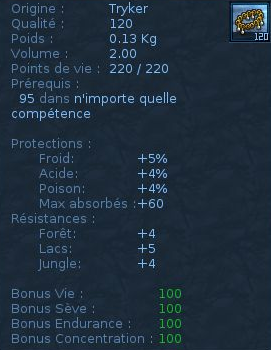
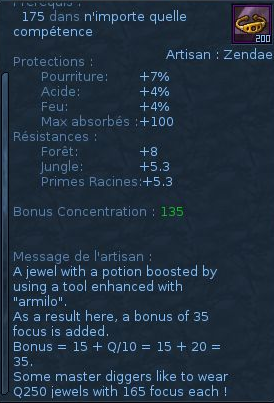
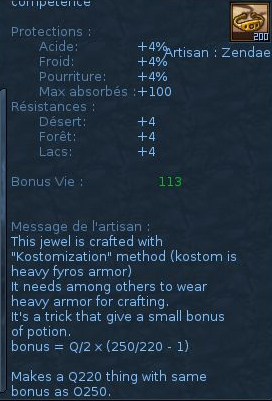
Jewelry and Magic Defense
Let's move on to the magical defense of the jewels.
This is a much more complex and exciting aspect than the first one!
And often neglected by novice hunters or magicians, or even masters.
Why? Because even if you know the theory, optimizing the magical defense of an ornament will require some planning, either from you or your mentors. But if your progress is fast, making a high value-added set of jewellery will not be worth the candle: you will soon have to make a new one. Young recruits usually evolve with jewellery without looking for a magical defence, get used to it and are always satisfied with it even once they have mastered it...
And yet, optimizing the magic defense would make you more efficient. Less effort for your healer, less untimely slips, better chances of survival. For example, it annoys me to see homins chasing the kincher without electrical protection.
As for novices, with the right finery, mowing intelligent plants becomes very easy di amataki, even alone.
In terms of magical defense, the most complex adornments are the war ornaments, which must cover you with all possible spells, those of offensive magic at the very least.
So in summary, we need a set with good magic defences for :
- Increase our survivability while on the move against untimely magical attacks from wildlife;
- Be more effective when hunting a specific species that we know has special magical attacks, and that we will hunt many times;
- To defend ourselves against magical attacks from other homins.
All this requires a knowledge of Atys and its dangers. Could you give me some examples of animals that are capable of performing an attack of elemental magical force?
In terms of magical defenses, we must distinguish two things: Protections and Resistances.
And to start with, every homin has natural magical protections and resistances, even in his birthday suit, di amataki. These mainly increase as you develop your skills as a warrior or magician.
Protections
Let's start with the easiest to understand: the Protections.
They only concern offensive magic: Acid, Cold, Rot, Fire, Poison, Shockwave and Electricity.
That's seven types of elemental forces in all.
]All homins naturally have a 10% protection rating against acid, cold, and rot. And, depending on their race of sap, an additional 20% protection rate,
fire for the fyros, poison for the matis, shockwave for the trykers and electricity for the zorais.
These protection rates do not increase with training, but what does increase is the ]absorption threshold, which is equal to half of your highest combat or magic skill, and is the maximum you can take from a magic attack without suffering damage.
Hmm you follow di amatakima? Okay, here's an example:
Imagine Be'mayol Jicky, a 10th Circle melee combat tryker ―without jewel― , melee beeing his highest skill.
He has a natural absorption threshold of 50 magic damage (100 / 2 ).
- He gets hit by a cold spell from a defensive Stinga, causing 200 damages.
He absorbs 10% of the damage, a decrease of 20 damages, which is well below his absorption threshold of 50.
In the end, he suffers 200 - 20 = 180 damages.
- Later Be'mayol meets Yberkan, a very rare bird.
He suffers a shock wave of 400 damages by annoying one of its guards.
According to his natural protection rate against the shock wave, he could absorb 20% of it, that is to say 80 damages.
But 80 is higher than the threshold of 50, di amatakizo! It's the smaller one that wins.
so in the end he still suffers 400 - 50 = 350 damages.
In both cases, it will expose our novice Tryker to danger.
But he can protect himself with jewelry, which will have two effects:
- Increase certain levels of protection;
- and increase the maximum absorption threshold.
Or, say in more detail:
- Each standard design piece of jewelry increases three of seven protection levels up to +8%;
- Each piece of jewelry increases the wearer's absorption rate by a value equal to half its quality.
Suppose our tryker Be'mayol gets a Q120 set.
In addition to 600 additional health points, this will already raise its absorption rate to 50 (natural) + 60x10 (jewels) = 650 damages. That's better, isn't it?
Let's assume that our tryker has a special set of jewels, each of which gives him 8% extra protection against shock waves.
This gives him in theory 10 x 8% = 80%...
On top of that his 20% natural ! So in total 100% protection !? Wow! Immune!?
Well... no...
because the maximum protection a homin can have against an elemental force is 70%.
Still, with 70% protection against shock waves and also let's assume - let's be crazy - 70% protection against the cold;
in the previous attack examples, Be'mayol would only have suffered 60 out of 200 damages from the stinga,
and 120 out of 400 from the Yber.
That's a pretty big defense, especially if the attacks are repeated.
In my opinion, a good magic defense will save you much more often than a potion value just a little higher on the jewel.
A Q200 set instead of Q250 is a deficit of 250 potions of life.
250 is a lot? no, just a pinch from a clopper.
Let's go back to our special set with +8 jewels.
A set offering 80% protection already represents a non-optimization since 10% is necessarily wasted, the maximum being 70%. Without forgetting that the homin may already have a natural protection.
But nothing obliges to have a set with all the identical jewels!
We can very well have a mix of different jewels to have a substantial coverage on a selection of elemental forces that we risk to undergo most frequently unexpectedly.
For example, a set that would cover electricity, acid, poison and fire... would seem to me to be valuable and reassuring.
Resistances
Well, now that you've fully grasped the concept of Protection, let's move on to Resistance.
As for protection, every homin has a natural resistance to magic spells. The fauna and flora are also able to resist our spells besides. I said spells and not forces. You can't withstand the electric shock of a Kincher, or the acidic spit of a Zerx. You can only resist spells, meaning incanted magical attacks. This is the case of attacks coming from homins, but also from intelligent plants, primitives, and some rare animals like the gubani.
When you successfully resist a spell, you don't suffer any of its effects!
Our natural resistance to spells is equal to our highest skill in combat or magic, minus 26 points.
You must therefore already have at least one level above 26 to benefit from any resistance.
The natural resistance of a master in melee or magic is therefore 250 - 26 = 224 points.
For non-battle skills, take half of their value as a basis.
More precisely, we have five kinds of resistances, one for each of the Domains of magic:
The Desert Domain;
The Forest Domain;
The Lake Domain;
The Jungle Domain;
The Prime Root Domain.
Each spell of elemental magic, but also of offensive and defensive affliction, is part of one of these Domains. Healing magic is not linked to a Domain, but ..., that said, no one wants to resist a healing spell, hahaha!
For example:
- If you have a high resistance to the *Jungle Domain*,
you can resist the electric spell of a Psykopla.
- If you have a high resistance to the *Lake Domain*,
you will be able to withstand the shockwave spell of the same Psykopla or the cold one of a Stinga.
It is therefore necessary to learn to which domain each spell belongs! At least every elemental magic spell.
Just as for Protection, there is for the magical resistance of the homins a specificity of sap breed, di amataki.
A homin will have an extra 10 points of resistance in the domain that corresponds to his sap.
For example, a tryker is more resistant to the spells of Lake Domain.
But because that would be too simple, there's also a region specificity!
For example, when we are in the Jungle, our resistance to the Jungle domain is decreased by 10.
By the way, this is also true for the fauna and flora.
It will less resist to electric spells in the jungle, and less to poison spells in the forest, and so on.
When we endure a spell, we have a chance to resist it.
The higher your resistance is, compared to the magic power of the attacker, the more likely you are to resist it.
It should be noted:
- For elemental magic, we compare the level of the spellcaster with the resistance of the target;
a master of elemental magic will always injure his target even with a weak spell;
- For offensive or defensive affliction, we compare the level of the spell with the resistance of the target;
so it requires a powerful spell to control powerful creatures;
- beyond a certain differential, your chances of resisting will never be more than three out of four (75%).
- or, formulated from another point of view: 1/4 of the attacks will always pass even with the best resistance[/i] …
Namely:
- Each standard jewel increases your resistance in three of five domains by up to +8.
- The values of resistances have a maximum value of 50 points above your highest magic or combat skill..
For example, our tryker Be'mayol Jicky from the 10th circle can therefore have a maximum resistance of 150, thanks to the jewels.
Which is already higher than the plants he'd reap to train alone.
If, to mow intelligent plants that only use magic attacks, you have a set that offers resistances AND protections against their spells, then mowing becomes even easier di amatakizo!
This even if the set is of a quality "Q" lower than what you can claim :
only 1/4 of the attacks will pass, with only 30% of their power…
Jewelry and Craft
Now let's talk about jewelry crafting!
The Resistances and Protections that a jewel provides are a function of the materials from which it was made.
The result depends on the selections and combinations of materials, as is the case with any craft.
Creating an optimized ornament, taking into account what you want to face, but also taking into account your natural defenses, often takes a lot of time. Not to mention the time to glean the materials afterwards! And ornaments are not eternal, they wear out! So you have to know how to accept compromises or get organised.
For example, the great guild craftsmen who have to equip the troops of novices will develop a recipe for plant jewelry, i. e. a recipe which is easy to glean materials for mass production, and which offers acceptable protection against the most hunted plants: psykoplas and cratchas.
It will be all the easier to produce if the recipe only requires material from digging, of which good quantities can be obtained quickly.
War sets, on the other hand, are only relevant once you are close to a level of master and therefore have the maximum natural resistance to spells. They are designed to discourage the opponent from using magic. Resistances and protections are distributed to cover all types of offensive magic spells.
Either you resist or you absorb!
If a spell is not covered by a resistance or protection, in the jargon, there is said to be a "hole".
If the hole is uncovered by the enemy, you will be swept systematically afterwards.
The war ornament represents a summit of Homin craftsmanship, invented here on the New Lands.
It is very effective against elemental magic, but remember that it is impossible to cover all the afflictions with a single jewelry set, because you can only maximally resist three of the five areas.
Besides, one cannot resist so well to offensive or defensive affliction even with a set.
We're almost done with this jewelry course.
I'm passing around new samples of jewelry thanks to the organizers with different settings: troop training jewelry, antikitin jewelry for the troops, veteran tracker jewelry, and war jewelry.
Artistic Jewelry
These jewels are made from hunting and digging materials from a single region.
They can bring interesting protections but are also beautiful gifts.
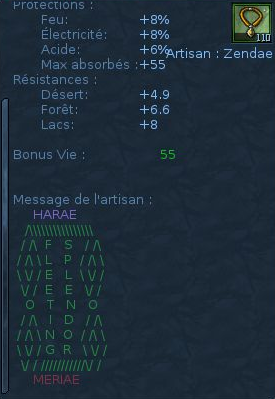
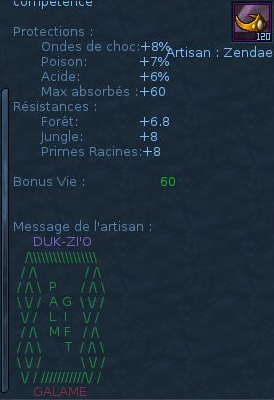

Utility jewellery
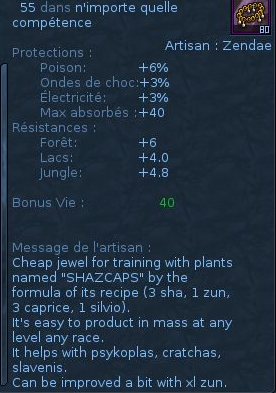
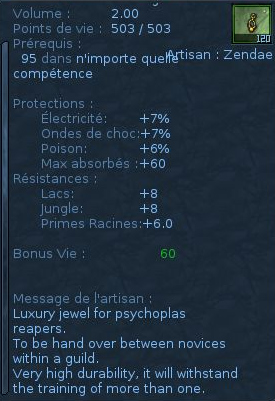
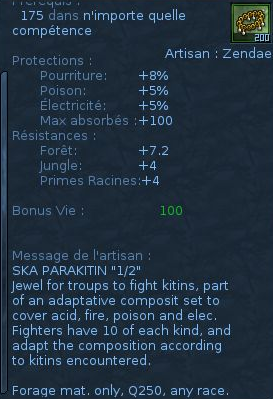
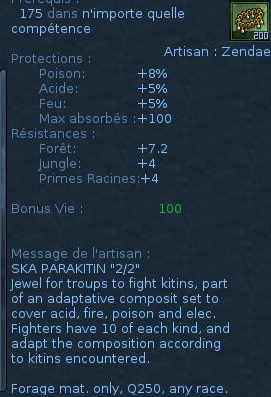
Elite Jewelry
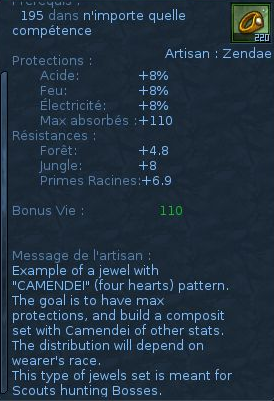
War/Combat Jewelry

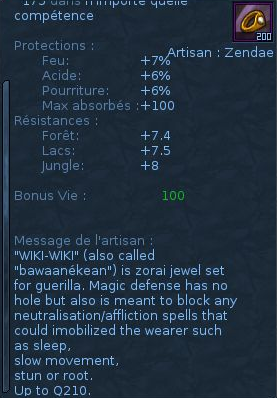
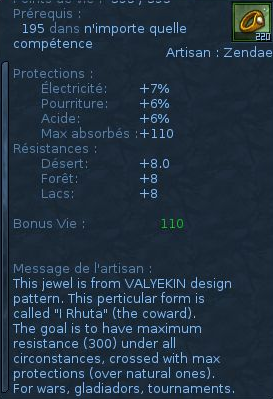
Jewelry and Plan
One last word on the durability of jewelry!
These are pieces of equipment that wear out very quickly. You have to consider the other scale of "quality" of objects.
Not the one that is given in numbers, but the one that depends on the plan used by the craftsman: basic, medium or high quality.
What influence does this have on the characteristics of the jewellery?
Absolutely none: a jewel of high quality will not necessarily have better characteristics than a jewel of basic quality.
Except its durability.
The durability of high-grade jewelry is much higher!
Just remember it when you no longer need to upgrade your finery every spring and will therefore be able to invest in sustainability.
Bibliography
Here, for those who would like to continue with readings...
You should know that there is a sheet on jewellery written, a long time ago, by Zorais from the former Wakwai monastery.
It sums up very well the essence of the magical defence by jewels. And shorter than what I've done today!
Jewelry File
(Only french version. The document dates from before a reform on jewellery resistance, but the gist is right).
For those who are more particularly interested in making, you can also read the diary of my discoveries in jewellery craftsmanship. I will continue to write it one day...
Jewellery Apprentice
I would like to thank the Fairhaven Market organizers for inviting me di amabini, in particular nair Kyriann.
And thank you, attentive listeners.
May this course benefit you.
Meriae! Hezivele! Umaferye!
Beauty! Curiosity! Virtuosity!
---
Kyriann Ba'Zephy RieAncienne Cheffe de la guilde Bai Nhori Drakani
Taliar
Mère de famille


